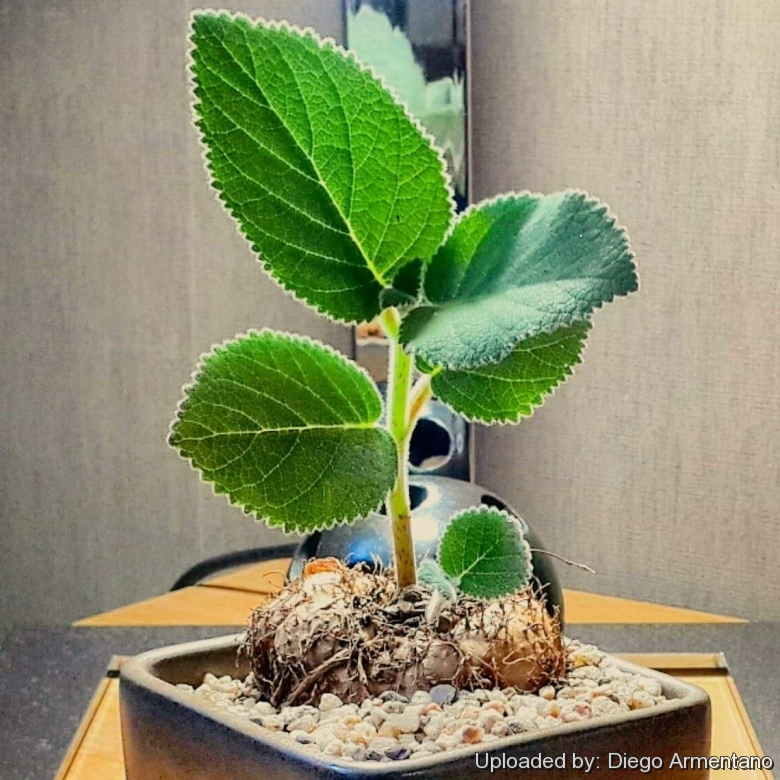




Your support is critical to our success.

Origin and Habitat: Sinningia insularisSN|35249]]SN|35249]] is endemic to the island of Alcatrazes, a small granitic island 30 km distant from the Sâo Paulo mainland , between the cities of Santos and Sào Sebastiào (morro do Recife). The island measures some 2.5 by 0.5 km and reaches 316 m on its highest point.
Habitat and ecology: This species grows in full sun in slopes on the higher areas of the island that are 60–70 degrees and are made of exposed granitic rock. Sinningia insularisSN|35249]]SN|35249]] share its rupicolous habitat with bromeliads (Tillandsia spp., Vriesea spp. and Canistrum lindenii), cacti (Cereus fernambucensisSN|4900]]SN|4341]], ColeocephaloSN'>4897' alt='4341'>Cereus fluminensis#SN#4900'>Coleocephalo[[Cereus fluminensisSN' style='border:none;'>), orchids (Oncidium fimbriatum, Cattleya tigrina, Epidendrum spp., etc) and the endemic Begonia venosa and Begonia larorum (Begoniaceae), and Anthurium alcatrazense (Araceae). The ornithophilic flowers of S. insularis make it attractive to hummingbirds. The absence of permanent water source and the distance from the mainland prohibits lasting human colonization, but the Brazilian Navy occupies some areas and occasionally uses them for shooting exercises.
Synonyms:
- Sinningia insularis (Hoehne) Chautems
- Rechsteineria insularis Hoehne
PORTUGUESE (Português): rainha-do-abismo
Description: Sinningia insularis is an herbaceous plant that grows among rocks. It has a round large tuber producing several narrow, tubular, flower clusters up to 35 cm tall at apex. Tubers get substantial. Its elegant habit and bright-orange flowers displayed over dark green leaves makes a nice addition to the many other pink or red-flowered species in cultivation. A distinctive feature of S. insularis is the large shiny red fruits.
Derivation of specific name: from Latin insula ("island").
Stem: 10-20 cm tall, herbaceous, annual, erect, simple, green to wine-red, pubescent to villous.
Leaves: 4 or 6 whorled at the apex of the stem (Variation of the basic number of leaves between two and three, within the same taxon, has been observed in several other Sinningia species). Petiole 5-20 mm long. Blade 5-9 cm long, 4-8 cm wide, ovate to orbicular, apex obtuse to acute, margin crenulate, base obtuse, upper face pubescent, tomentosa in the underside with 6-7 pairs of prominent secondary veins. The leaves are very firm and stiff, almost as much so as those of Sinningia macrostachya.
Inflorescence: Terminal pseudo-racemes, 10-20 cm long, racemes wine red with 6-24 flowers, in the axil of 2-3 leafy bracts, about 1 cm long. Peduncle inconspicuous. Pedicel 2-3 cm long, erect-ascending, wine red, pubescent.
Flowers:Abundant, rather small, reddish-orange about 4 cm long. Calyx-lobes 3 mm long, 1 mm wide, triangular. Corolla 2-3 cm, tubular, coral-orange, pubescent, base swollen with 5 small protuberances, then abruptly constricted, then progressively enlarging above.
History: It was firstly described as Rechsteineria insularisSN|35250]]SN|35250]] by Hoehne, in 1958. Chautems transferred it to Sinningia in 1990.
Bibliography: Major references and further lectures
1) Candollea, Conservatoire botanique., 1997
2) Pesquisas: Botânica, Edizioni 54-56, Instituto Anchietano de Pesquisas., 2004
3) Maria das Graças Lapa Wanderley, George John Shepherd, Ana Maria Giulietti, “Flora fanerogâmica do Estado de São Paulo.” FAPESP, 2001
4) Sinningia insularis in Burwur.net, web: http://www.burwur.net/sinns/4insMain.htm
5) Edélcio Muscat, Juliana Yuri Saviolli, Alexandre Costa, Carlos Alberto Chagas, Marcos Eugênio, Elsie Laura Rotenberg and Fábio Olmos. “Birds of the Alcatrazes archipelago and surrounding waters, São Paulo, southeastern Brazil” Check List 10(4): 729–738, 2014
Cultivation and Propagation: Sinningia insularis is an easy-to-grow species that self-pollinates readily. It is tolerant of full sun and occasional drought. It is one of the easiest sinningia species to grow, makes a large tuber, and flowers year after year. Needs good drainage, and bright spot to flower well.
Hardiness: S. insularis has tubers that are vulnerable to being cold while wet, more vulnerable than most other species.
| Your Actions | |
|---|---|
| Back to Sinningia index | |
| Back to Gesneriaceae index | |
 |
Back to Succulents Encyclopedia index |
Privacy stantement - Terms and conditions - How to cite - About us - Feedback - Donate




